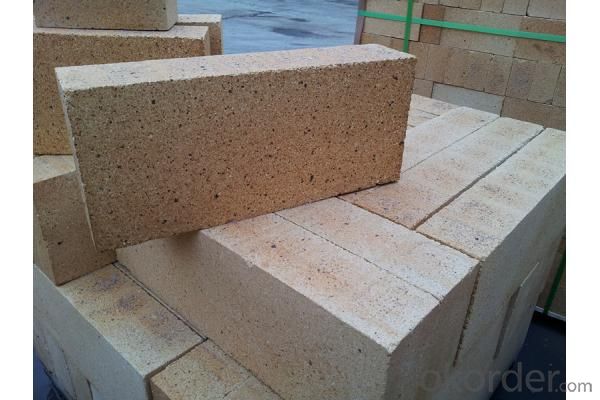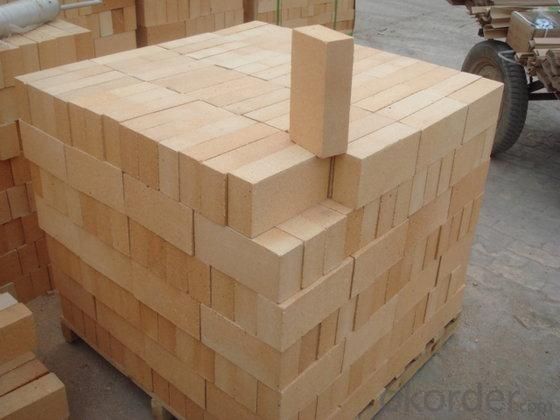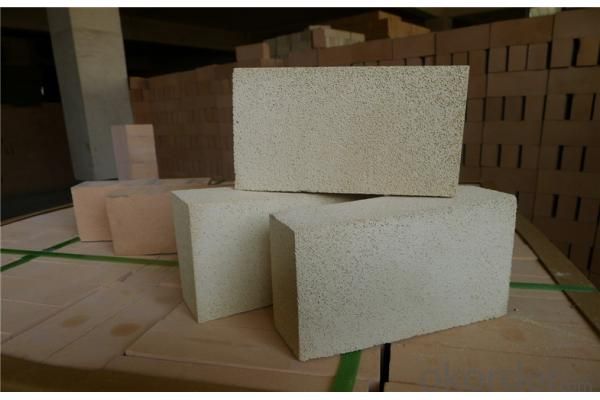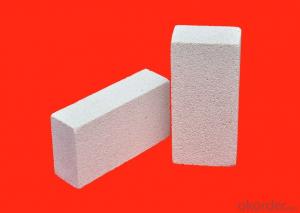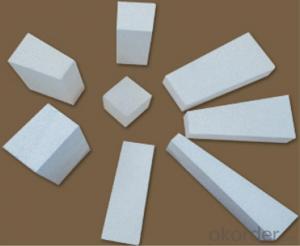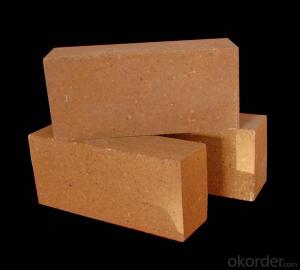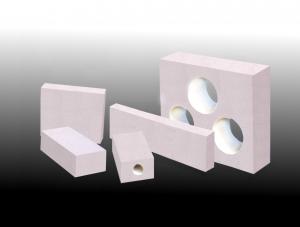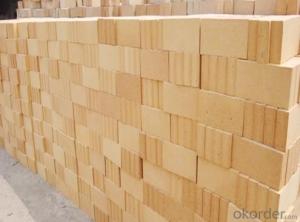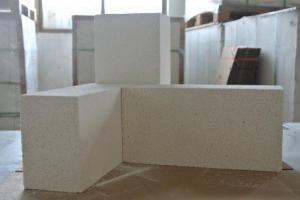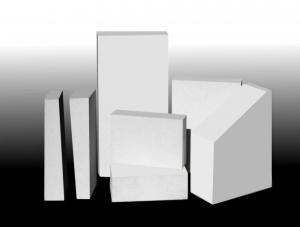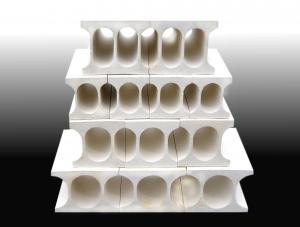Insulating Fire Brick - High Quality Refractory Mullite Insulating Fire Brick
- Loading Port:
- Tianjin
- Payment Terms:
- TT OR LC
- Min Order Qty:
- 10 m.t.
- Supply Capability:
- 10000 m.t./month
OKorder Service Pledge
OKorder Financial Service
You Might Also Like
CNBM conforms strictly to the requirements of ISO 9000 quality control system during the production. MSDS is also available if you want. The thermal insulation fire clay brick meet with the requirements of ASTM & JIS standards. So please stay cool with our quality.
Application
Insulating Fire Brick are used for the lining of converter, alternating current arc furnace, direct Current arc furnace and the ladle slag line, etc.
Insulating Fire Brick Technical index
Brand Quality | JM23 | JM26 | JM28 | JM30 | JM32 | |
Bulk Density (g/cm3) | 0.52 | 0.78 | 0.88 | 1.03 | 1.25 | |
1.2 | 1.6 | 2.1 | 2.5 | 3.5 | ||
Modulus of Rupture (Mpa) | 0.9 | 1.4 | 1.6 | 2.1 | 2.1 | |
-0.5 | 1400℃ -0.4 | 1510℃ -0.5 | 1620℃ -0.9 | 1730℃ -0.9 | ||
Thermal Expansion 1100℃(%) |
0.5 |
0.7 |
0.8 |
0.9 |
1.1 | |
Thermal conductivity(W/m.k)
| 400℃ | 0.14 | 0.27 | 0.32 | 0.41 | 0.49 |
600℃ | 0.16 | 0.29 | 0.34 | 0.43 | 0.50 | |
800℃ | 0.18 | 0.31 | 0.36 | 0.44 | 0.51 | |
1000℃ | 0.20 | 0.33 | 0.38 | 0.45 | 0.53 | |
Al2O3 | 37 | 58 | 67 | 73 | 77 | |
Fe2O3 | 0.7 | 0.7 | 0.6 | 0.5 | 0.4 | |
Equipment
1 unit of Ceramic Abrasive (SG Abrasive) pilot production line
2 units of Compact grain Abrasive pilot production lines
1 unit of high-end coated abrasives (abrasive cloth) production line
2 units of Boron Carbide production lines
3 large flexible crushing and sieving lines for grit production lines
2 units of 2000KVA furnaces for Boron Carbide fusion
6 units of 5000KVA-10000KVA dumping type electric arc furnaces for Brown Fused Alumina fusion
Company Advantage
(1)Long Insulating Fire Brick manufacture history: 25 years manufacturer
(2)Advanced equipment
(3)Diversification of production standards: ISO ANSI FEPA JIS ASTM
(4)Flexible payment: T/T L/C D/P D/A
(5)Professional marketing team and after-sale service
(6)Free sample
FAQs
Q1 |
What’s the transport method? |
A1 | FCL delivery goods with wooden pallet or wooden case by sea; If LCL delivery, must with wooden case; Sometimes need open top, flat rack or bulk cargo. |
Q2 |
What’s the required payment term? |
A2 | Generally 30% TT as the prepayment, 70% TT before delivery. If need, 100% Irrevocable Letter of Credit or negotiation. |
Q3 |
Which country are our products exported to? |
A3 | Apart from entire Chinese market, the US, Russia, Japan, Korea, Australia and some Southeast Asian Nations. |
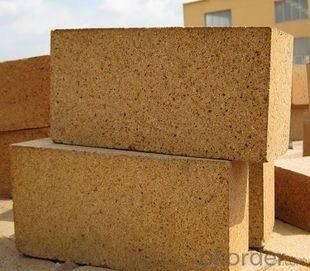

- Q: Can insulating fire bricks be used in the construction of glassware production furnaces?
- Yes, insulating fire bricks can be used in the construction of glassware production furnaces. Insulating fire bricks are designed to have low thermal conductivity, which means they are able to withstand high temperatures while providing effective insulation. This makes them ideal for use in furnaces where glassware production takes place, as they help to retain heat and minimize energy loss. Additionally, insulating fire bricks are resistant to thermal shock, which is important in glassware production where rapid temperature changes can occur. Overall, the use of insulating fire bricks in the construction of glassware production furnaces helps to ensure efficient and safe operation of the equipment.
- Q: Can insulating fire bricks be used in the construction of high-temperature reactors?
- Yes, insulating fire bricks can be used in the construction of high-temperature reactors. These bricks are designed to withstand and retain high temperatures, making them suitable for use in applications such as high-temperature reactors where heat insulation is required.
- Q: Are insulating fire bricks easy to cut or shape?
- Yes, insulating fire bricks are relatively easy to cut or shape. They can be cut using basic tools such as a saw or a knife, and they can also be shaped by using a chisel or sandpaper. Their soft and lightweight composition allows for easier manipulation and customization to fit specific requirements.
- Q: Can insulating fire bricks be used in high-velocity gas flow applications?
- Yes, insulating fire bricks can be used in high-velocity gas flow applications. Insulating fire bricks are designed to have excellent thermal insulation properties, low thermal conductivity, and high resistance to temperature fluctuations. These characteristics make them suitable for various high-temperature applications, including high-velocity gas flow environments. When exposed to high-velocity gas flow, insulating fire bricks can maintain their structural integrity and insulation properties, providing effective thermal insulation and protection. They are often used in applications such as kilns, furnaces, boilers, and other industrial equipment where high-velocity gas flow is present. However, it is important to consider the specific requirements and characteristics of the gas flow in the application. Factors such as temperature, pressure, and chemical composition of the gas should be taken into account to ensure that the insulating fire bricks are compatible and can withstand the conditions. In summary, insulating fire bricks can be used in high-velocity gas flow applications due to their thermal insulation properties and resistance to temperature fluctuations. However, it is crucial to consider the specific requirements and characteristics of the gas flow to ensure proper compatibility and performance.
- Q: Can insulating fire bricks be used in the construction of ceramic fiber kilns?
- Yes, insulating fire bricks can be used in the construction of ceramic fiber kilns. Insulating fire bricks provide excellent thermal insulation, which helps to retain heat and improve energy efficiency in kilns. They are often used as the lining material in kilns to prevent heat loss and ensure efficient firing processes.
- Q: Are insulating fire bricks resistant to alkali-silica reaction?
- Yes, insulating fire bricks are generally resistant to alkali-silica reaction due to their low alkaline content and high silica content.
- Q: Can insulating fire bricks be used in refractory fibers?
- No, insulating fire bricks cannot be used in refractory fibers. Insulating fire bricks are solid bricks made from refractory materials and are used for insulating and retaining heat in high-temperature applications. On the other hand, refractory fibers are lightweight and flexible materials made from ceramic or mineral fibers. They are used for insulation and lining in various industrial applications, including furnaces, kilns, and boilers. The two materials have different properties and structures, and are not compatible with each other. Therefore, it is not recommended to use insulating fire bricks in refractory fibers.
- Q: Can insulating fire bricks be used in chimneys or flues?
- Insulating fire bricks are not recommended for use directly in chimneys or flues. While these bricks are designed to withstand high temperatures, they are primarily used for insulation purposes rather than as a structural component. Chimneys and flues require bricks that are specifically engineered to withstand the intense heat and corrosive byproducts of combustion. These bricks, known as refractory bricks, are designed to have high thermal resistance and exceptional durability to ensure the safe and efficient operation of the chimney or flue. Therefore, it is advisable to use refractory bricks instead of insulating fire bricks when constructing or repairing chimneys and flues.
- Q: Can insulating fire bricks be used in the construction of fireplaces?
- Yes, insulating fire bricks can be used in the construction of fireplaces. Insulating fire bricks are designed to withstand high temperatures, making them an ideal choice for lining the interior of a fireplace. They have excellent thermal insulation properties, helping to retain heat within the fireplace and prevent excessive heat transfer to the surrounding structure. This not only improves the efficiency of the fireplace but also reduces the risk of damage to the surrounding walls. Insulating fire bricks are lightweight and easy to handle, making them convenient for construction purposes. Additionally, they are resistant to thermal shock, meaning they can withstand rapid temperature changes without cracking or breaking. Overall, insulating fire bricks are a reliable and effective choice for constructing fireplaces.
- Q: How thick should the insulation layer be when using insulating fire bricks?
- The thickness of the insulation layer when using insulating fire bricks depends on various factors such as the desired level of insulation, the temperature of the surrounding environment, and the specific application or purpose of the insulation. In general, insulating fire bricks are designed to provide excellent thermal insulation, which means they are capable of reducing heat transfer effectively. However, the thickness of the insulation layer should be determined based on the specific requirements of the project. For applications where high-temperature insulation is needed, a thicker layer of insulating fire bricks is typically recommended. This is because a thicker layer can provide better insulation and reduce heat loss more effectively. Additionally, a thicker insulation layer can also enhance the overall structural integrity of the insulation system. On the other hand, for applications where lower temperature insulation is needed or for projects with space constraints, a thinner layer of insulating fire bricks may be sufficient. In such cases, it is important to consider the specific thermal conductivity properties of the insulating fire bricks being used and ensure that the desired insulation requirements are met. It is also worth noting that insulation requirements may vary based on local building codes, safety regulations, and industry standards. Therefore, it is advisable to consult with professionals or experts in the field to determine the optimal thickness of the insulation layer when using insulating fire bricks for a specific project.
Send your message to us
Insulating Fire Brick - High Quality Refractory Mullite Insulating Fire Brick
- Loading Port:
- Tianjin
- Payment Terms:
- TT OR LC
- Min Order Qty:
- 10 m.t.
- Supply Capability:
- 10000 m.t./month
OKorder Service Pledge
OKorder Financial Service
Similar products
Hot products
Hot Searches
Related keywords



